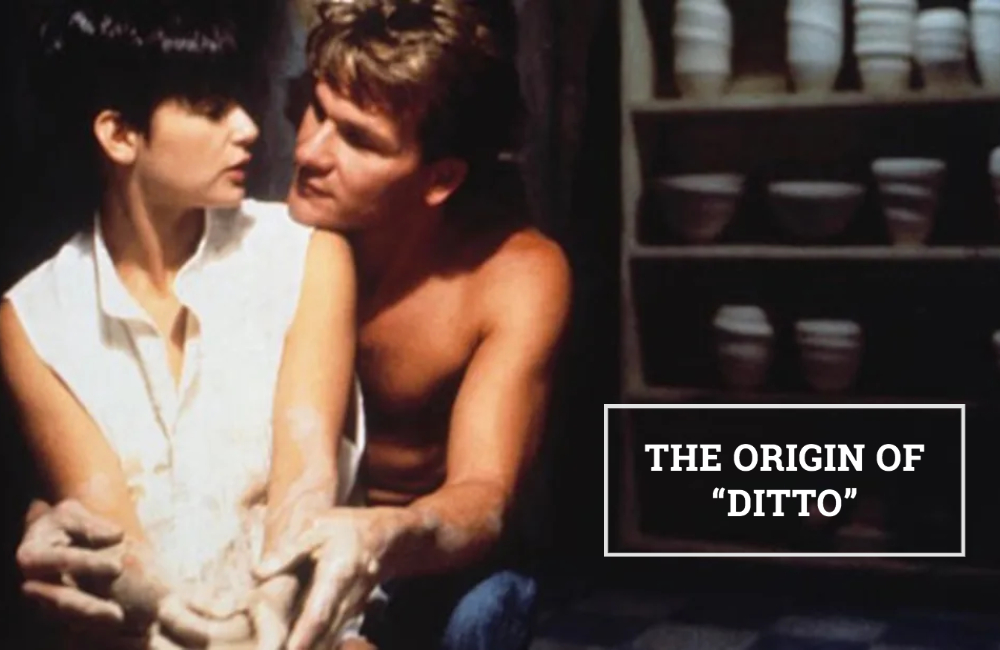
Each week here at the Australian Writers’ Centre, we dissect and discuss, contort and retort, ask and gasp at the English language and all its rules, regulations and ridiculousness. It’s a celebration of language, masquerading as a passive-aggressive whinge about words and weirdness. This week, that’s what she said…
Q: Hi AWC, I was talking to someone recently and they said “ditto”.
A: OMG – was it Patrick Swayze’s ghost?
Q: No, I was not talking to Patrick Swayze’s ghost.
A: Were you at least doing some kind of pottery?
Q: No.
A: Okay, sorry. Please continue.
Q: So, it got me thinking – where did the term “ditto” come from? I thought it might make for an interesting discussion.
A: Ditto.
Q: So, let me have a guess. It sounds Italian, like a Nespresso flavour.
A: You’re correct – it does come from an Italian term that had Latin roots.
Q: Oh, my cousin from Toowoomba married a Venezuelan with pink hair, but she definitely had Latin roots.
A: Um, no, not that kind. “Detto” was the original Italian word – past participle of “dire” – to say – which in turn was derived from the Latin “dicere” – to say or speak. So, initially “detto” meant something similar to “said”.
Q: That’s what she dettoed! Yeah, nah, it’s not the same…
A: Meanwhile in Tuscany, their dialect saw them spell it as “ditto”.
Q: So I’m seeing sunflowers and vineyards and those thin pointy trees, but I’m not seeing much about “same again” in all this.
A: Not yet. But the Tuscans liked to use “ditto” in another way. One that meant “in the month/year of the same name”. It was used to avoid repetition.
Q: Example?
A: Well, instead of saying 28 Dicembre, 29 Dicembre, 30 Dicembre, you might have instead said 28 Dicembre, 29, 30 ditto. Or something even more Italian than that.
Q: Allora!
A: Sorry?
Q: It’s something Italians say all the time. Just trying to make it more authentic.
A: Excellent. Anyway, English quite liked this time saving device, so they grabbed “ditto” for themselves in the 1620s. And by the 1670s, they’d broadened its use beyond months and years to simply mean “the aforesaid, the same thing, same as above” for anything. This meaning remains today, but its use as a verb has faded.
Q: As a verb?
A: Yes. It was very common into the 19th century for writings to use “dittoed” as a synonym of “repeated”. So someone might have dittoed another’s opinion. There was even a “ditto machine” in the mid-20th century that used carbon paper and came before photocopying.
Q: Wow. So we were dittoing before we were xeroxing?
A: Exactly. And while the verb “dittoing” still exists, you’re more likely to see “ditto” used as a noun or adverb. An adverbial example might be: “Australia has many wildfires in February; ditto California in August.” Or: “She kept the rice in a large silver tin with a gold label on it. Ditto the lentils.”
Q: What about the keen wah?
A: Oh, you mean the quinoa? Sure, it can also have a silver tin. But the biggest thing “ditto” is used for today is simply as a “me too” form of agreement.
Q: A kind of “me too” movement, if you will?
A: No, we will not. So if someone says “nice to meet you”, you might say “ditto” in reply. It’s essentially “right back atcha” wrapped up in a more efficient package.
Q: What about the ditto mark?
A: “
Q: Yes, that.
A: It looks like double quotes, but is often referred to as a “pair of apostrophes”. And yes, it would typically be placed directly below the thing which it is copying. It’s a useful shorthand technique to avoid rewriting the same thing.
Q: So in summary, “ditto” came from Italian and today can either be used to signify repetition OR agreement.
A: Or if you’re Whoopi Goldberg, to prove the existence of Patrick Swayze’s ghost.
Q: I think it’s time to leave.
A: Ditto.
Do you have a question you’d like us to explore? Email it to us today!
About us
Contact us